Petrobras
-
- Brazil Offshore: Petrobras & Subsea Engineering Marine Technology, Nov 2013 #34
Brazil’s Petrobras has been one of the leading players in deepwater, subsea development projects since the turn of the century. These projects include pre-salt and post-salt plays, which require extensive and complex subsea engineering and construction efforts. It would be impossible for Petrobras to develop all of its projects alone, therefore much is done by specialized companies, mostly of foreign origin. “We could not have advanced in this project (pre-salt) conventionally, developing the production individually. We needed a global vision of the projects, starting from a high level plan,” said José Formigli, Petrobras’ Executive Director of E&P, speaking of the primary plan for the development of the pre-salt at the Santos Basin, the Plansal, which was created in 2008. According to Formigli, “The Plansal led to a ‘virtuous cycle,’ which has guaranteed better results each year.”
In the last 10 years Petrobras investment in R&D grew 22.7% per year, reaching $1.1 billion in 2012. Petrobras rarely operates alone when it comes to subsea engineering and construction. Partnerships are part of Petrobras’ DNA and by working in cooperation with institutions such as the ANP (National Petroleum Regulator), universities such as the Federal University of Rio de Janeiro (UFRJ) and service companies like FMC Technologies, Subsea 7 and DeepOcean, Petrobras has found solutions to many problems and challenges in subsea development that might have taken much longer to realize if the company were to go at it alone.
Some of the problems and challenges are directly related to the harsh environment where the constructions are undertaken, specific challenges are strong deepwater currents, irregular and unstable seafloor, along with equipment corrosion and equipment failure during and after installation, to name just a few. “It is important to have access to reserves, technology and the adequate mechanisms to manage production to be competitive,” said José Miranda Formigli, Petrobras’ E&P Director during the recent Offshore Technology Conference (OTC Brazil 2013) in Rio de Janeiro.
“In terms of wells and subsea, we have problems associated with hydrate formation and, in some cases, we have also to make work-over on the wells for sand control, and I would say traditional workover for replacing gas lift valves. So this is a very traditional work-over that we have to do in all fields with the mature areas that we have in Campos Basin. Beside that, in some areas we have also some electrical submersible pump replacement work to be done. For example, this affected P-57 production,” said Formigli.
Teaming with FMC Technologies
In terms of subsea engineering FMC Technologies is at the forefront with important projects in Brazil, such as the subsea separation system at the deepwater Marlim field at the Campos Basin, which is one of the major global subsea separation projects in existence. “Subsea oil/water separation, as-delivered in Marlim is the first step in removing enough water to prevent flow assurance issues,” said Rob Perry, Director of global subsea processing systems for FMC Technologies.
Marlim is Petrobras’ largest field in the Campos Basin, located 110 km (70 miles) offshore Rio de Janeiro. It was once considered the world’s largest subsea development, with 129 wells and 8 floating production units (FPU), devoted to the extraction of oil and gas. The Marlim field is spread out between depths of 640 to 2,590m (2,100 to 8,500 ft.), with the separation system itself located at the 900m mark (2,950 ft). This is the first system worldwide to include deepwater subsea separation of heavy oil and water, with sand removal systems and reinjection of water to boost production in this mature field. The separation system also includes cyclone modules that will perform water treatment before re-injecting the water back into the reservoir. The separated gas is added back to the oil stream to aid its lifting to the FPU, while the separated water is pumped back into the reservoir to further increase production. FMC supplied the subsea separation and pumping system, utilizing a novel pipe separator design, licensed and developed in cooperation with Statoil. The system is being engineered by FMC’s operations in Brazil, Norway and the Netherlands with final manufacturing and integration activities performed at the company’s Rio de Janeiro facility. For this project FMC is responsible for the offshore commissioning and for technically assisting in the installation. “Marlim is the fifth field in the world that will utilize FMC’s subsea separation technologies,” said Tore Halvorsen,. “The project will enable a broader application of our separation technologies for future subsea processing opportunities.”
Subsea 7
Subsea 7 is another major Petrobras partner in subsea engineering and construction projects. Only this years Subsea 7 has been awarded a $350m, five-year contract for a pipe-laying vessel. The contract covers the operation of Kommandor 3000, a 118 m PLSV with a top tension capacity of 15 tons, two work class ROVs, two 30 ton cranes and three carousels for flexible pipes. The PLSV is capable of installing flexible lines, umbilicals and equipment to a depth of 2,000m and will start work under the contract this year. Victor Bomfim, Subsea 7’s Senior Vice President for Brazil, said “Subsea 7 has one of the most advanced vessel fleets in the world for subsea engineering and construction, and we look forward to supporting Petrobras in future developments.” Another important Subsea 7 project is the seabed-to-surface Guará-Lula NE project. Guará and Lula are part of the large pre-salt discoveries made by Petrobras in the Santos Basin, Brazil in ultradeep water depths of beyond 2,100m, 300km from shore. The Guará-Lula NE project is a US$ 1billion contract awarded to Subsea 7 in 2011 by Petrobras and to date is the largest EPIC-SURF contract awarded in Brazil. The project scope includes the subsea engineering and the subsea installation of four decoupled riser systems featuring large submerged buoys supporting 27 steel catenary risers. The engineering and project management work is ongoing at Subsea 7’s offices in Rio de Janeiro. The SCRs are being reel-laid by the Seven Oceans vessel and hooked-up to the subsea buoys. The production and water injection lines are constructed predominantly from Mechanical Lined Pipe (BUTTING BuBi). This is a result of a joint development programme by Subsea 7 and BUTTING, with Petrobras participation. Offshore installation commenced during the second half of 2012, using Seven Oceans, Acergy Polaris and Skandi Seven.
The system includes:
• 4 submerged buoys each weighing about 2,000 tonnes to be installed approximately 250 meters deep, buoy foundations and associated tethers
• 27 steel catenary risers of 3.9km
• 21 x associated pipeline end terminations (PLETs) of which 18
• 7.5-inch production lines, three 9.5-inch water injection lines and six 8-inch gas injection lines
• 27 x anchor suction piles
• 4 x monitoring systems for buoys and SCRs
On October 21 Subsea 7 was awarded two new contracts with a combined value in excess of $600 million from Petrobras, for operation of the PLSVs Seven Mar and Seven Condor on a day rate basis for approximately three years, with operations starting toward the end of 2013 for Seven Mar and in the third quarter of 2014 for Seven Condor. Both vessels have operated for Petrobras for several years and are currently under contract with the national operator. The work scope of the contract is similar to that of other PLSVs which Subsea 7 currently operates offshore Brazil, comprising project management, engineering and installation of flowlines, umbilicals and equipment supplied by Petrobras. “Following on from the renewal of contracts for the K3000, Seven Phoenix and Normand Seven, the renewal of contracts for Seven Mar and Seven Condor further strengthens our presence in the day-rate PLSV business segment in Brazil,” said Victor Bomfim, Senior Vice President for Brazil.
Over the years Petrobras has installed an expressive amount of subsea equipment and underwater pipelines up to 3000m deep. In many cases it is impossible to inspect them with intrusive techniques, and the need of advanced underwater in-service inspection tools and self-monitored equipment has become imperative. The CENPES, Petrobras’ Research Center is focused on advancing inspection and monitoring technologies to face these challenges, leading a project which main goal is provide reliable and practical solutions applied to SURF components inspection (subsea structures, Xmas trees, umbilicals, control systems and subsea piping). Many tools are being developed locally and show how much subsea engineering has developed in Brazil in the last 10 years. CENPES is also working on developing new and more efficient systems, methods and procedures for deepwater subsea construction, with a eye at increasing subsea construction efficiency for the many deepwater pre-salt development set to take off in the coming years, including the recently auctioned Libra pre-salt field, which is expected to require something to the tune of 60 to 90 support vessel, many of which will be exclusively used for subsea construction efforts. “Development of subsea systems and equipment, new or optimized, are vital to produce in deep and ultra-deep waters, pursuant to concepts of compact subsea oil, water and gas separation, re-injection of produced water into the seabed, gas-lift technology enhancement, subsea gas compression, oil boosting from the seabed, and a new generation of submersible electric pumps,” said Marcos Isaac Assayag, Director of the CENPES Research Center.
Petrobras is looking to improve its the pre-salt production systems and reserve recovery factor by intensive use of compact subsea solutions, injection systems, and by improving the capacity of new pre-salt FPSO units. In order to do this Petrobras and partners are constantly working on the development of subsea systems and equipment, new or optimized, to produce in deep and ultra-deep waters, experimenting concepts of compact subsea oil, water and gas separation, reinjection of produced water into the seabed, gas-lift technology enhancement, subsea gas compression, oil boosting from the seabed and a new generation of submersible electric pumps. “One of the new technologies related to subsea engineering comprises the new flexible riser top connector for use in deep and ultra-deep waters features an innovative design that allows the pipe to be anchored onto the connector without traction reinforcement bending. This improves traction reinforcement structural performance, enabling greater fatigue resistance of the risers’ system. The connector concept was developed and patented by Petrobras and engineered by the Federal University of Rio Grande do Sul(UFRGS). A prototype was assembled on a flexible line sample and passed the initial tests. Fatigue performance tests are currently in progress at UFRGS. Once the technology has been confirmed by the qualification tests, Petrobras may license the connector to the traditional suppliers in the area,” said Assayag.
The Steel Lazy Wave Riser
Another interesting Petrobras development in subsea engineering is the Steel Lazy Wave Riser (SLWR) setup, which has optimized the cost of the Sapinhoá Norte riser collection system. The technology enables the use of steel risers connected directly to an FPSO. This riser system includes the use of floats in mid-water so as to afford a geometry that will provide the steel tube resistance to fatigue during the life of the project. Petrobras undertook extensive optimization studies on the system’s structural configuration for the Santos Basin scenario, which enabled the choice of the SLWR for Sapinhoá Norte. The study allowed for the minimization of pipes with metallurgical clad in the production risers; that could be substituted in 70% of the length of the risers, for mechanical clad ones, which are less expensive and more readily available on the market. This will be the first SLWR connected to an FPSO anchored by spread mooring system, and the first in the Santos Basin pre-salt region. This will be the fourth system in the world to use the SLWR, after the Bonga Field, in Nigeria, the Parque das Conchas (BC-10), in the Espírito Santo Basin, and the Stones Field, in the Gulf of Mexico (still under development). However, Petrobras is reportedly having a frustrating time installing these riser-buoys, which are considered to be key equipment to increase production at the Sapinhoá and Lula Northeast plays. The project includes four submerged riser buoys, each weighing around 2,000 tons, hooked up in pairs to two FPSOs. “We have faced serious problems in the installation of the first of these two systems and this has caused long delays. The reason for this includes susceptibility that the installation vessel (Seven Polaris) has shown to maritime conditions,” said Formigli.
He also explained that the first buoy is still held by temporary tethers but installation is expected to move forward in November, as maritime conditions in the South Atlantic become more agreeable with the onset of summer. The first pair of riser buoys are expected to start producing by the end of January, several months after the original deadline.(As published in the November/December 2013 edition of Marine Technology Reporter - www.seadiscovery.com)
-
- Arpoador Shipyard and Pre-salt FSVs Maritime Reporter, Nov 2016 #78
Logistics hubs and Fast Supply Vessels will be key assets in the complex offshore transport solution Petrobras has devised for moving workers and goods, to and from Brazil’s remote pre-salt plays. Here is a look at a modern local shipyards building the heavy-duty aluminum vessels, with overall lengths
-
- Offshore Brazil: The Libra Field & Brazil’s Pre-Salt Policy Maritime Reporter, Nov 2013 #56
was in any way surprised, as the state policy is to maintain tight control over pre-salt E&P. The new rules being implemented for this auction, such as Petrobras being the sole operator of the field and having a minimum 30% stake in any consortium, along with the highly criticized decision to create another
-
- Cenpes Leading Petrobras’ R&D Effort Marine Technology, Apr 2013 #32
Petrobras expects to raise a net $4.3 billion in global capital markets each year to fund its investment plan over the next five years, according to Chief Financial Officer Almir Barbassa. During a presentation to analysts on March 19th, Barbassa explained that the expected increase in crude oil production
-
- Shipbuilding, Repair and Conversion: Brazil's Quick Fix Maritime Reporter, Jan 2015 #30
has been squarely on newbuild. On the other hand, Brazil’s ship conversion industry has enjoyed steady growth, growth directly related to orders from Petrobras, mostly to convert VLCC tanker hulls to FPSOs. According to Ariovaldo Rocha, President of SINAVAL (Ship Construction, Repair and Offshore National
-
- IMODCO To Provide Petrobras With World's Deepest CALM Terminals Maritime Reporter, Oct 1989 #17
catenary anchor leg mooring (CALM) terminals ever undertaken. The IMODCO-designed terminals, to be constructed by Setal for Petroleo Brasileiro (Petrobras), Brazil's national oil company, will be installed in a record 400 meters of water in the Marlim Field, offshore Brazil in the Campos Basin of the
-
- IMODCO Receives Order From Petrobras For $5-Million SPM Terminal Maritime Reporter, Jul 15, 1981 #7
for a Single Point Mooring terminal, valued at approximately $5 million, has been awarded to IMODCO, a unit of AMCA International Corporation, by Petrobras, the national oil company of Brazil. To be sited in the Campos Basin offshore Brazil in 338 feet of water, the terminal will permanently moor
-
- Davie Signs $C35-Million Petrobras Rig Contract Maritime Reporter, Jan 15, 1980 #37
Davie Shipbuilding Limited of Lauzon, Quebec, Canada, announced r e c e n t l y that it has signed a $35-million Canadiandollar contract with Petrobras (Brazil's national petroleum company) for the construction of a 300-foot marine jackup drilling platform. The contract, signed in Rio de Janeiro
-
- ABS Innovates For Petrobras Project Maritime Reporter, Nov 2000 #40
of theoretical interest to the offshore industry, is the key element of a new first-of-its-kind program being developed by ABS Group Inc., for the Petrobras 100,000- bpd 35 FPSO (pictured on page 27), operating in the Campos Basin offshore Brazil - Marlin Field, in 2,788 ft. of water. The program,
-
- Dresser-Rand Equips Petrobras FPSO Maritime Reporter, Apr 2002 #76
Brazil will include gas compression modules worth approximately $35 million from the Dresser- Rand Company. The FPSO. which will operate in the Petrobras Albacora Leste field, is anticipated to produce approximately 180,000 barrels of oil and 6 million cu. m. of gas a day. The compression equipment
-
- IMODCO Wins Petrobras Contract To Install SPM At Record Depth Maritime Reporter, Dec 1977 #47
IMODCO, pioneer offshore marine terminal systems company, a division of Amtel, Inc., has received a contract of several million dollars from Petrobras, national oil company of Brazil, for the engineering and design of a Single Point Mooring (SPM) terminal. It is for speedy installation in the
-
- Enseda Shipbuilding & Surviving the Petrobras Crisis Maritime Reporter, Jan 2016 #34
Enseada Shipbuilding was established to build deepwater drillships for Petrobras. Seventy percent of the company is owned by a consortium composed of Brazilian companies, Odebrecht (50 percent), OAS (25 percent), UTC (25 percent), with the remaining 30 percent belonging to Japanese shipbuilding giant
-
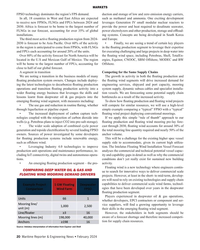 )
February 2024 - Maritime Reporter and Engineering News page: 20
)
February 2024 - Maritime Reporter and Engineering News page: 20challenging and large projects in deep water into Over 80% of the activity forecast for North America will be the ? oating wind space, including Petrobras, Shell, TotalEn- located in the U.S and Mexican Gulf of Mexico. The region ergies, Equinor, CNOOC, SBM Offshore, MODEC and BW will be home to the
-
 )
September 2023 - Marine Technology Reporter page: 64
)
September 2023 - Marine Technology Reporter page: 64and Environmental Enforcement (BSEE). was part of an ongoing contract to provide IRM services for The BSEE is funding the project with a grant to UH re- Petrobras. The project involved a remote piloting upgrade of searchers Zheng Chen, Bill D. Cook Assistant Professor of the workclass ROV system on board
-
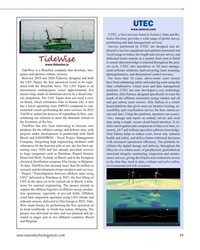 )
September 2023 - Marine Technology Reporter page: 49
)
September 2023 - Marine Technology Reporter page: 49the erating since 2020 and has already provided services lifecycle of a subsea asset, of geophysical, geotechnical, to large companies such as Petrobras, Repsol Sinopec structural integrity monitoring, inspection and mainte- Brasil and Shell, Technip, in Brazil, and to the European nance surveys
-
 )
May 2023 - Marine Technology Reporter page: 43
)
May 2023 - Marine Technology Reporter page: 43oil and gas sector. The ZMAX-Planova consortium is acting as the integrator, pulling all of this expertise together to deliver a completed network for Petrobras. Of course, this approach creates unique challenges in the coordination of materials, equipment, and subcomponents between suppliers and installers
-
 )
May 2023 - Marine Technology Reporter page: 42
)
May 2023 - Marine Technology Reporter page: 42pared to satellite connections that can be severely impacted by other at Praia da Macumba, state of Rio de Janeiro. weather and other natural events. Petrobras is highly motivated in increasing capacity and security in the transmission of real-time data from offshore Are there any distinct differences
-
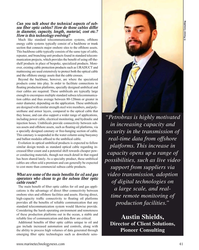 )
May 2023 - Marine Technology Reporter page: 41
)
May 2023 - Marine Technology Reporter page: 41wire members, and poly- urethane and armor layers, compared to the optical cable that they house, and can also support a wider range of applications, “Petrobras is highly motivated including power cable, electrical monitoring, and hydraulic and injection hoses. Umbilicals provide connectivity between sub- in
-
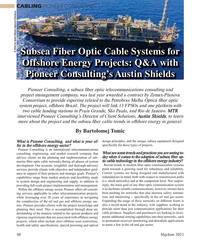 )
May 2023 - Marine Technology Reporter page: 40
)
May 2023 - Marine Technology Reporter page: 40CABLING PIONEER CONSULTING © 2022 by Andre Ribeiro/Agência Petrobras Subsea Fiber Optic Cable Systems for Offshore Energy Projects: Q&A with Pioneer Consulting’s Austin Shields Pioneer Consulting, a subsea ? ber optic telecommunications consulting and project management company, was last year awarded a
-
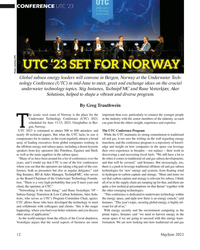 )
May 2023 - Marine Technology Reporter page: 12
)
May 2023 - Marine Technology Reporter page: 12energy and subsea space, including a dozen keynote edge and insight on how companies in the space can leverage speakers from key operators like Petrobras, Equinor and Shell, their own experience to broaden – not replace – their work in as well as the main suppliers in the subsea space. discovering
-
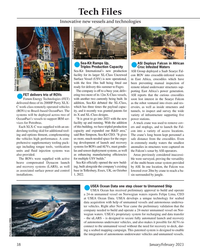 )
January 2023 - Marine Technology Reporter page: 38
)
January 2023 - Marine Technology Reporter page: 38OceanPact’s vessels to support IRM ser- “It is great to go into 2023 with the new power stations. facility up and running. With the addition vices for Petrobras. A truck crane was used to remove cov- of this building, we have tripled production Each XLX-C was supplied with an un- ers and stoplogs, and to
-
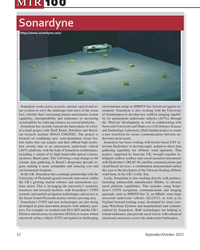 )
September 2022 - Marine Technology Reporter page: 52
)
September 2022 - Marine Technology Reporter page: 52has recently entered the latest phase of a ? rst- Newcastle University and Thales on a UK Defence Science of-a-kind project with Shell Brasil, Petrobras and Brazil- and Technology Laboratory (Dstl) funded project to create ian research institute SENAI CIMATEC. The project is a new waveform for secure
-
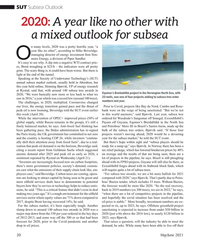 )
May 2021 - Marine Technology Reporter page: 20
)
May 2021 - Marine Technology Reporter page: 20the group), it’s still a Payara off Guyana, Equinor’s Breidablikk in the North Sea ? nely balanced market, he says. Anti-fossil fuel thinking has and Petrobras’ Mero III in Brazil’s Santos basin, made up the been gathering pace, the Biden administration has re-signed bulk of the subsea tree orders, Bjørvik
-
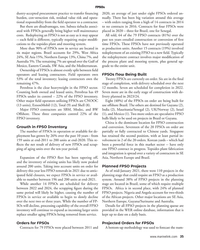 )
February 2021 - Maritime Reporter and Engineering News page: 35
)
February 2021 - Maritime Reporter and Engineering News page: 35own the Twenty FPSOs are currently on order. Six are in the ? nal remaining 47%. stage of completion, with delivery scheduled over the next Petrobras is the clear heavyweight in the FPSO sector. 12 months. Seven are scheduled for completion in 2022. Counting both owned and leased units, Petrobras
-
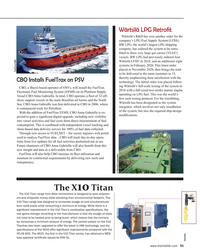 )
January 2021 - Maritime Reporter and Engineering News page: 51
)
January 2021 - Maritime Reporter and Engineering News page: 51the system Sea. CBO Anna Gabriella was ? rst delivered to CBO in 2006, where integrator, which involves not only installation it commenced work for Petrobras. of the system, but also the required ship design With the addition of FuelTrax EFMS, CBO Anna Gabriella is ex- modi? cations. pected to gain
-
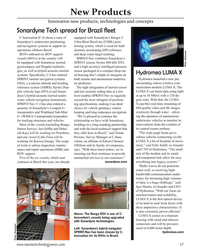 )
November 2020 - Marine Technology Reporter page: 57
)
November 2020 - Marine Technology Reporter page: 57the comfort of Santos Service, Joe Grif? n and Debo- and with the local technical support that its control rooms onshore. rah Kay) will be working for Petrobras, they offer here in Brazil,” said Tomás “The wide-angle beam gives and one vessel (Cabo Frio) will be Peixoto, Survey Manager at C-Inno- subsea
-
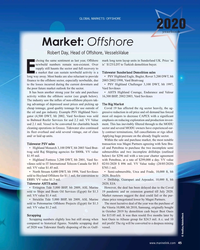 )
June 2020 - Maritime Reporter and Engineering News page: 45
)
June 2020 - Maritime Reporter and Engineering News page: 45, the most notable Tidewater PSV sales transaction was Magni Partners agreeing with Sete Bra- • Highland Monarch 3,100 DWT, blt 2003 Vard Brat- sil and Petrobras to purchase the two incomplete semi tvag sold Raj Shipping agencies for $800k. VV value submersibles and two incomplete drillships (outlined $1
-
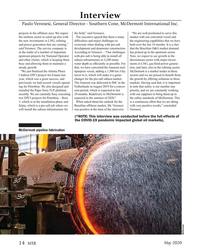 )
May 2020 - Marine Technology Reporter page: 14
)
May 2020 - Marine Technology Reporter page: 14solutions to these previously we had several vessels operat- The Amazon was delivered to IHC in the markets. Having said that, it is important ing for Petrobras. We also designed and Netherlands in August 2019 for a conver- to note that safety is our number one installed the Papa-Terra TLP platform sion
-
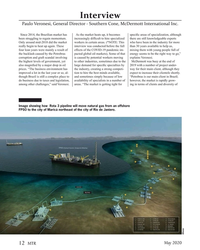 )
May 2020 - Marine Technology Reporter page: 12
)
May 2020 - Marine Technology Reporter page: 12help us, four lean years were mainly a result of effects of the COVID-19 pandemic im- mixing them with young people full of the backlash caused by the Petrobras pacted global oil markets), Some of that energy seems to be the right way to go,” corruption and graft scandal involving is caused by potential
-
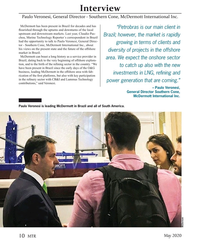 )
May 2020 - Marine Technology Reporter page: 10
)
May 2020 - Marine Technology Reporter page: 10Interview Paulo Veronesi, General Director - Southern Cone, McDermott International Inc. McDermott has been present in Brazil for decades and has “Petrobras is our main client in fourished through the upturns and downturns of the local upstream and downstream markets. Last year, Claudio Pas- Brazil
-
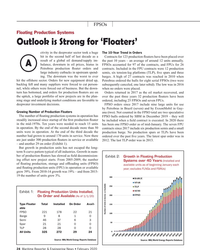 )
February 2020 - Maritime Reporter and Engineering News page: 24
)
February 2020 - Maritime Reporter and Engineering News page: 24years – an average of around 12 units annually. balance, downturn in oil prices, hiatus in FPSOs accounted for 97 of the contracts, and FPUs for 26 A Petrobras production ? oater orders and contracts. Included in the FPU contracts were 12 production large industry cutbacks in upstream spend- semis, six
-
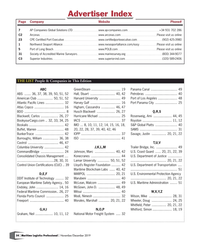 )
Nov/Dec 2019 - Maritime Logistics Professional page: 54
)
Nov/Dec 2019 - Maritime Logistics Professional page: 54............... 19 Panama Canal ............................. 49 ABS ....... 36, 37, 38, 39, 50, 51, 52 Hall, Stuart ........................... 40, 42 Petrobras ................................... 40 American Club ................. 50, 51, 52 Harvard University ....................... 49 Port of Los Angeles
-
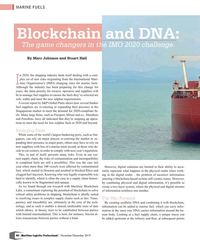 )
Nov/Dec 2019 - Maritime Logistics Professional page: 40
)
Nov/Dec 2019 - Maritime Logistics Professional page: 40their presence in the Singaporean market to meet the demand for 2020-compliant fu- els. Many large frms, such as Freeport, Mitsui and co., Marubeni and Petrobras, have all indicated that they’re stepping up opera- tions to meet the need for low-sulphur fuels in 2020 and beyond. Emerging Risks While some of
-
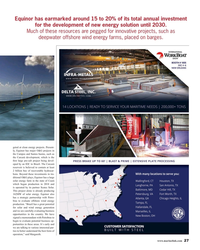 )
November 2019 - Maritime Reporter and Engineering News page: 27
)
November 2019 - Maritime Reporter and Engineering News page: 27for solar and wind energy generation and we are carefully evaluating business opportunities in the country. We have signed a memorandum with Petrobras to begin to evaluate potential business op- portunities in these areas. It´s early and we are talking to various interested par- ties to better
-
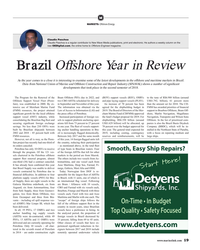 )
January 2019 - Maritime Reporter and Engineering News page: 19
)
January 2019 - Maritime Reporter and Engineering News page: 19and 2019. The Board of Directors of the Mer- support to Bourbon Offshore, Bram Off- signi? cant growth for the local offshore the press of? ce of Petrobras. chant Marine Fund (CDFMM) approved shore, Marlin Navigation, Magallanes support vessel (OSV) industry, while Increased participation of foreign
-
 )
November 2018 - Marine Technology Reporter page: 33
)
November 2018 - Marine Technology Reporter page: 33this turbulent scenario, Sistac remained stable focused on the most relevant costs and expenses, which rep- and managed to extend three contracts with Petrobras: ser- resent about 80% of the total, and the second wave focuses on vices such as industrial climbing, diving contracts and imple- the remaining
